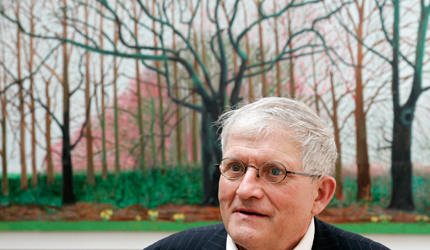The British Pop Art Movement gained a fresh energy when David Hockney emerged on the scene. He’s both a controversial and highly influential figure, known particularly for his versatility, and for being one of the most popular British artists of the 20th century.
David Hockney’s Early Days
David Hockney was born on July 9, 1937, in Bradford, England. His parents, writes PBS, would have been considered quite radical at the time; his father an antiwar activist and his mother a vegetarian.
As a young boy, Hockney knew quite early that he wanted to become an artist. He studied at the Bradford School of Art and later fulfilled his National Service duties in a hospital. In 1959, Hockney enrolled at the London College of Art.
Although Hockney’s artistic skills were recognized at school and he was noted as an important contributor to the pop movement, Hockney didn’t excel academically. In fact, he flunked out twice before he graduated.
In the 1960s, Hockney taught at the universities of Iowa, Colorado and California and began traveling back and forth between England and the United States. He moved to Los Angeles permanently in 1978.
Sources in This Story
- PBS: David Hockney: The Colors of Music
- Encyclopedia Britannica: David Hockney
- Los Angeles County Museum of Art: David Hockney Portraits
- Annely Juda Fine Art: David Hockney: Drawing in a Printing Machine
- Tate: David Hockney: The East Yorkshire Landscape
- The Guardian: Candid camera
- Harper’s Bazaar UK: David Hockney Is Tate Britain’s Most Visited Exhibition Ever
- David Hockney: Works
Hockney’s Art
Although he has proven his talent in many artistic disciplines, including photography, drawing and printmaking, Hockney’s true gift may be that of portraiture. Hockney says that to capture a person’s personality a portrait needs, “to be directed through my heart to my eye to my hand,” and that newer technologies cannot capture the essence of a person in the way that a painted portrait can.
Hockney has had numerous solo art exhibitions around the world, as well as a touring retrospective that visited the Los Angeles County Museum of Art, the Metropolitan Museum of Art in New York and the Tate Gallery, London.
Hockney has famously used unlikely mediums for his fine art, such as polaroid prints and faxed images. One of his shows, “Drawing in a Printing Machine” at the Annely Juda Fine Art gallery, featured portraits and landscapes drawn by Hockney using his computer; the resulting images were printed at very large scale to show the detail and skill involved in creating them.
The Rest of the Story
As an artist, Hockney often contemplated how his predecessors performed their work. He studied centuries’ worth of paintings, and eventually presented a theory that masters like Caravaggio and Rembrandt used lenses to essentially trace some of their finest work. He wrote the book “Secret Knowledge” to discuss his theory; a documentary on the subject later followed.
In 2007, he exhibited five new paintings from his East Yorkshire landscape series at the Tate to mark his 70th birthday. Hockney became intrigued by Yorkshire as a teenager, but it wasn’t until decades later that he used the area for artistic inspiration.
When preparing to paint a landscape, Hockney would study a scene for hours before even touching his paintbrush. The Tate Britain said Hockney’s work “conveys the land and light in electric colour, bringing to the canvases his love of place, freshly observed and infused by decades of experience and the memories that it conjures of childhood days.”
In 2017, the Tate Britain held a retrospective to mark Hockney’s 80th birthday. The exhibition, which was open for nearly four months, drew more than 478,000 visitors and was the museum’s most visited exhibit ever.
More of Hockney’s work from over the years, including paintings, drawings, photos and mixed media pieces can be seen on his web site.
This article was originally written by Lindsey Chapman; it was updated June 1, 2017.











